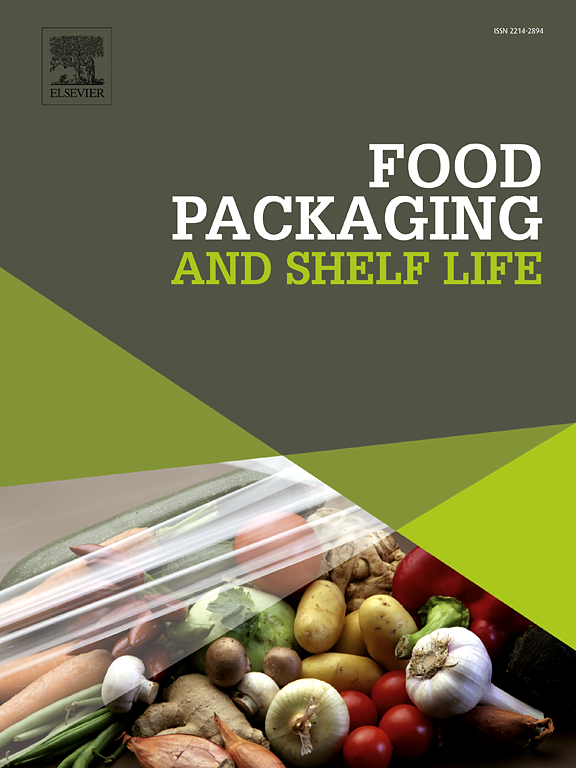以聚乙烯醇为稳定剂,设计新型食品包装用水性聚乳酸涂料
IF 10.6
1区 农林科学
Q1 FOOD SCIENCE & TECHNOLOGY
引用次数: 0
摘要
以聚乙烯醇(Pv)溶液为稳定剂,十二烷基硫酸钠(SDS)为表面活性剂,采用两步乳化蒸发法制备了水性聚乳酸(PL)涂料。首先,通过在乙酸乙酯中混合18 % (w/v)的PL溶液和不同体积的Pv水溶液(浓度范围在2 %和11.6 % (w/v)之间)来制备各种PL乳液。用低浓度Pv溶液(2 % w/v)制备的乳液由于缺乏稳定性而全部废弃。在稳定溶液的基础上,采用乙酸乙酯蒸发法制备PL分散体。通过改变Pv浓度和稳定剂体积,获得了6种PL/Pv比为42/58 ~ 70/30的PL/Pv分散体。对聚乳酸乳液和分散体进行了流变学表征,并通过物理和工艺性能对聚乳酸乳液和分散体进行了表征。制备的涂层分散体的粘度主要受Pv浓度的影响。复合膜的红外光谱分析揭示了两种聚合物的化学基团之间的相互作用,并通过热重分析证实了这一点。Pv浓度和相对湿度对复合膜的水蒸气吸附性和透氧性均有较大影响。在最高Pv比和最低RH条件下,PO2的减少更为明显。虽然复合膜的PO2随相对湿度的增加而增加,但其阻氧性能是对照PL膜的15 ~ 5倍。本文章由计算机程序翻译,如有差异,请以英文原文为准。
Designing novel waterborne polylactic acid coatings for food packaging applications including polyvinyl alcohol as stabilizer
Waterborne polylactic acid (PL) coatings were successfully prepared through a two-step emulsification-evaporation process by using polyvinyl alcohol (Pv) solutions as stabilizer and sodium dodecyl sulfate (SDS) as surfactant. First, various emulsions of PL were carried out by mixing a 18 % (w/v) PL solution in ethyl acetate with diverse volumes of Pv aqueous solutions at concentration ranging between 2 % and 11.6 % (w/v). The emulsions developed with low concentrated Pv solutions (2 % w/v) were all discarded due to lack of stability. From the stable solutions, PL dispersions were prepared by ethyl acetate evaporation. By modifying Pv concentration and the volume of stabilizer, six PL dispersions were successfully obtained with PL/Pv ratio varying from 42/58–70/30. Both the PL emulsions and dispersions were rheologically characterized and the latter were used to obtain cast composite films that were characterized through their physical and technological properties. The viscosity of the developed coating dispersions were mainly governed by Pv concentration. FTIR analysis of composite films revealed interactions between chemical groups of both polymers that were confirmed by thermogravimetric analysis. Both the water vapor sorption and the oxygen permeability (PO2) of composite films were highly affected by the Pv concentration and the relative humidity (RH). The reduction of PO2 was more noticeable at the highest Pv ratio and the lowest RH. Although, PO2 of composite films increased as RH increased, their oxygen barrier was between 15 and 5 times better than control PL film.
求助全文
通过发布文献求助,成功后即可免费获取论文全文。
去求助
来源期刊

Food Packaging and Shelf Life
Agricultural and Biological Sciences-Food Science
CiteScore
14.00
自引率
8.80%
发文量
214
审稿时长
70 days
期刊介绍:
Food packaging is crucial for preserving food integrity throughout the distribution chain. It safeguards against contamination by physical, chemical, and biological agents, ensuring the safety and quality of processed foods. The evolution of novel food packaging, including modified atmosphere and active packaging, has extended shelf life, enhancing convenience for consumers. Shelf life, the duration a perishable item remains suitable for sale, use, or consumption, is intricately linked with food packaging, emphasizing its role in maintaining product quality and safety.
 求助内容:
求助内容: 应助结果提醒方式:
应助结果提醒方式:


